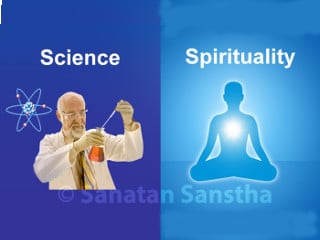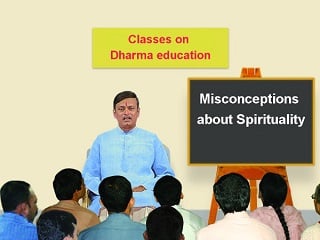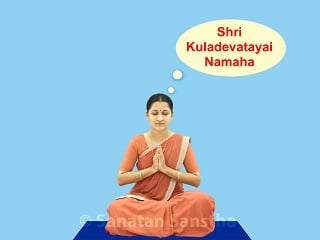One may ask, why in this age of scientific research and progress, are we ignoring the modern physical sciences and going in the supposedly reverse direction to the study of the science of Spirituality? According to the saying ‘Old is gold’, to make spiritual progress it is the eternal science of Spirituality alone and not modern physical sciences which is useful.
1. Meaning of the word science
Science has various meanings such as specific knowledge, scientific knowledge, philosophical knowledge, direct knowledge and knowledge of Brahman (God in His aspect as the Creator of the universe). However, generally knowledge that is acquired through the sense organs by analysis and experimentation of gross substances and natural phenomenon following a specific order and procedure is called Vidnyān (Science).
According to the Holy text Shrī Dāsbodh, the meaning of modern science is as follows.
Sākshittva (A state of an observer) is the act pertaining to vruttī (Basic nature), whereas unmanī (Thoughtless state) is nivrutti (Cessation of participation in worldly affairs). Pure science is the point where the awareness that ‘I know’ dissolves. ll 50 ll
In front of Parabrahman (Supreme God), ignorance dissolves and knowledge disappears. Even the vidnyān-vrutti (Experiences) disappears (Only advait [Non-duality] remains). ll 51 ll
2. Science is a branch of Spirituality
When we say ‘science’, almost always we think of ‘modern science’. Rationalists and average people think that ‘science’ and ‘Spirituality’ are two separate aspects. Spirituality means the knowledge of infinity, that is, knowledge of all subjects ! Then, why would Spirituality not include science ? It can be said that science is a branch of Spirituality.
Theoretically, Sanatan Hindu Dharma has described two types of sciences: Parāvidyā and Aparāvidyā.
-
Parāvidyā means supreme science.
-
Aparāvidyā means inferior sciences.
To understand more about it please read article “Why the society came to consider ‘science’ and ‘Spirituality’ as two separate aspects and why it is not so in reality.
3. Limitations of physical science
A. Physical Science cannot save us from unhappiness every time and cannot help overcome unhappiness caused by spiritual causes. New inventions of physical science providing happiness are suicidal.
B. There is an increase in man’s unhappiness and downfall of moral values due to physical science
C. Physical Science is incomplete, untrue and transient, whereas Spirituality is complete, true and eternal. The ‘Truth’ in science constantly undergoes changes The ‘Truth’ in Spirituality never undergoes change
D. What a person understands immediately through sādhanā (Spiritual practice), it takes several years, enormous funds and huge manpower for physical science to understand
E. Through science, only gross knowledge is obtained; whereas, through Spirituality (Meaning sādhanā here) along with the gross, we obtain knowledge of the subtle.
F. Physical sciences are unreliable. On the contrary, science of Spirituality is a complete and reliable science.
G. Physical science fails to go to the root cause of problems and find solutions.
H. Physical science does harmful effects on man’s life.
I. There is no guarantee that scientific knowledge will not be misused, but there is a guarantee that spiritual knowledge will not be misused. The knowledge of Spirituality is received only by the deserving, it is not misused, Only people with faith and sāttviktā use spiritual knowledge and mantras for their spiritual progress and for the welfare of the world.
J. The immortality of the Nation is decided by the establishment of Dharma (Righteousness), not by scientific progress.
To understand more about it please read article “Limitations of Physical Science”
The difference between physical sciences and Spirituality is understood from the table ahead.
| Physical Sciences | Spirituality | |
|---|---|---|
| 1. Origin | Western countries | Eastern countries |
| 2. What is it called? | A. Information B. experience |
Spiritual knowledge Spiritual experience |
| 3. What is that which perceives the information/spiritual knowledge called? | Jiva | Inferior spiritual knowledge – Jivatma, superior spiritual knowledge – Shivatma (A God-realised soul) (Note 1) |
| 4. What is that information/spiritual knowledge about? | Gross aspects such as the word, touch, form, taste, odour, emotion, thought etc. | Initially – Subtle-fragrance, subtle-sound etc. so also subtle aspects such as aura, waves etc. Finally – Atma |
| 5. From where is the information/spiritual knowledge obtained? | Externally. The five sense organs, mind and intellect too are external with respect to the jiva | Initially from the Guru and later from within. The jiva undertaking spiritual practice and the God-realised soul acquire spiritual knowledge from within, that is, from the soul |
| 6. Medium of obtaining information/spiritual knowledge obtained | Information is acquired externally through the five senses and internally through the mind and intellect | Divine knowledge is realised through the sixth sense, that is, the jiva undertaking spiritual practice and the God-realised soul |
| 7. Difference in meaning | Absent | May be present, for instance, the implied meaning is interpreted differently by people at different spiritual levels |
| 8. What are they connected with? | A. Maya (Note 2) B. Ignorance C. Objects containing the trigunsD. As Brahman exists in unlimited forms in Maya, for example, in food, speech, sound etc. the subjects are endless E. Gross F. Entire Creation G. Things which undergo dissolution H. Psychology is one branch of science in which the sub-conscious mind is studied with the objective of eliminating unhappiness |
Brahman, the Atma Spiritual Knowledge Trigunatit (Objects beyond the three components) The sole object is the eternal and infinite BrahmanSubtle The creator of everything The eternal Brahman The universal mind, Brahman is studied in order to attain Anand |
| 9. Objective | Achieving temporary happiness | Attaining eternal Anand |
| 10. Methodology | A. Understanding the difference between various objects (Dvait [Duality]) B. Relative to an object: Relative to place, time and object. Hence, it has limitation of place and time C. Dependent on the object (Place, time and the object are required) |
Perceiving the similarities or oneness between various objects (Advait [Non-dualiry])Not relative to an object: Not relative to place, time and object as everything is nothing but Brahman Independent of the object (Place, time and the object are not required) |
| 11. State in which information/spiritual knowledge is acquired | Waking state | A. Samadhi (Super conscious state) B. Sahajavastha (Natural state of communication with God) C. Sadhna Mukti (Liberation when still embodied) |
| 12. New creation | Impossible, Highlighting what already exists or charging in | Possible |
| 13. Dehabuddhi (Body awareness) | Present | Absent |
| 14. Dvait (Duality) / Advait (Non-duality) | There is duality between intellect and information | Since the one in pursuit of Brahman merges into it, there is advait |
| 15. Duration of the experience/spiritual experience | A. Short B. Whatever is learn through experience in this birth has to be learned again in the next, for example, writing reading etc (Note 3) |
Depends upon the duration of the superconscious state, continuous in the natural state of communication with God and external in liberation (Mukti) Whenever is learned through spiritual experiences in this birth is carried forward to the next one (Note 4) |
| 16. Quality | Inferior (Note 5) | Supreme |
| 17. Extent | Limited (Note 5) | Unlimited |
| 18. End | Occurs, for example, when it is discovered that all types of energies are created from single energy, it will be the end of physics. After the discovery of that basic element from which all elements are created, it will be the culmination of chemistry | Does not occur |
| 19. Boredom | May occur | Does not occur |
| 20. contentment | Temporary, since after realising one ‘Truth’, one feels like knowing the next | Present. After one acquires the spiritual experience of self-realisation, nothing more is left to be experienced. Hence, one experience Anand |
| 21. Definition | ‘विगतं ज्ञानं यस्मात् तत्’, means, that from which Dnyan (knowledge) has departed is Vidnyan (Science); this is how the word science can be humorously but meaningfully defined | ‘सा विद्या या विमुक्तये’, means only that which liberates is called spiritual knowledge. This spiritual knowledge is acquired only through the science of spirituality |
| 22. Fame | Occurs fast, since it is useful in day-to-day life | Occurs slowly, since there is hardly any connection with day-to-day life |
| 23. Relation with other subjects | Absent | All subjects including the physical sciences are a part of Spirituality (Note 6) |
| 24. Extent | Temporary | Eternal |
| 25. Effect | Attitude of enjoying materialism increases | Bhav of sacrifice increases |
| 26. Bhav towards Sadhana | Absent | Bhav that acquiring spiritual knowledge is sadhana |
| 27. Spiritual progress | Does not take place | Takes place |
Note 1
-
The Jīvātmā (Individual who has undertaken sādhanā) is one which has experienced the Ātmatattva (Soul Principle) to some extent. Rather, it is the individual which has got inferior level of spiritual experiences. Inferior spiritual experiences are related to the five subtle sense organs, mind and the intellect, for example, experiencing fragrance in the absence of an incense-stick, knowing the answer to a query.
-
Shivātmā is one which has almost blended with Shiv (God Principle), that is, the individual which has got superior level of spiritual experiences. Superior spiritual experiences are in relation to siddhīs (Higher supernatural powers), Ānand (Bliss) and Shānti (Peace).
Note 2 – Hence, this is like running after a mirage. By doing so, one never gets the Truth.
Note 3 – Knowledge as understood by the intellect is collected in the cells of the brain. When the cells of the brain start decaying due to old age, many aspects are not remembered. Conversely, as spiritual experiences are experienced by the Jīvātmā and the Shivātmā, they are never forgotten.
Note 4 – Knowledge as understood by the intellect is not useful in the next birth, for example, in all births we have to learn ‘A, B, C, D…’ Conversely, spiritual experiences of the Jīvātmā and the Shivātmā are registered in the next birth also.
Note 5 – ‘Physical sciences are incomplete in one sense since at any given point in time some of its questions remain unanswered. If ever they are solved, new questions arise.’
Note 6 – Gautam Budhha has said that waves of Tama component are18 times subtler than waves of light.
4. It is necessary that modern science and Spirituality go hand in hand
The famous scientist Einstein said, ‘Science is handicapped without religion and religion is blind without science’. Inventions made by modern scientists have their seed in the knowledge amassed by our ancient Sages and Seers. This proves that our ancient Sages and Seers had a scientific temperament. Swami Vivekanand also promoted understanding of science. During those times, institutions that respected Swami Vivekanand were told by Him to teach the subject of science in the schools administered by them. The best aspect is that due to modern science our life has easy and it saves time (For example, using a washing machine saves time spent in washing clothes). Hence, one should utilise this time for performing more and more sādhanā. In short, while making use of science, one should not move away from the path of sādhanā, and should see to it that both go hand in hand.
5. Supporters of science should forego their
rigid stance and personally experience Spirituality
Supporters of science take a rigid stance that there does not exist anything whose cause-and-effect aspect cannot be proved by intellect (For example, God). The cause-and-effect aspect in all the incidents in the world cannot be understood merely by the intellect. That is why, supporters of science who consider that knowledge obtained with the help of sense organs is only true cannot reach the ultimate Truth. Once knowledge of the soul is obtained with the help of sādhanā, one can understand the ultimate Truth.
Reference: Sanstha’s Holy Text on ‘Introduction to Spirituality‘ and ‘Spirituality‘


 Obstacles faced when studying Spirituality
Obstacles faced when studying Spirituality Importance of Spirituality
Importance of Spirituality Misconceptions about Spiritual practice ( Sadhana )
Misconceptions about Spiritual practice ( Sadhana ) Qualities essential for Spiritual practice ( Sadhana )
Qualities essential for Spiritual practice ( Sadhana ) Why are we born?
Why are we born?